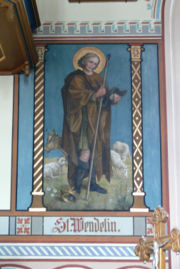
Wendelin of Trier
Encyclopedia

Saint Wendelin or Wendelin of Trier (b. c. 554; probably d. 617) was a hermit
Hermit
A hermit is a person who lives, to some degree, in seclusion from society.In Christianity, the term was originally applied to a Christian who lives the eremitic life out of a religious conviction, namely the Desert Theology of the Old Testament .In the...
and abbot
Abbot
The word abbot, meaning father, is a title given to the head of a monastery in various traditions, including Christianity. The office may also be given as an honorary title to a clergyman who is not actually the head of a monastery...
.
Life
There is very little definite information about this saintSaint
A saint is a holy person. In various religions, saints are people who are believed to have exceptional holiness.In Christian usage, "saint" refers to any believer who is "in Christ", and in whom Christ dwells, whether in heaven or in earth...
. His earliest biographies (two in Latin
Latin
Latin is an Italic language originally spoken in Latium and Ancient Rome. It, along with most European languages, is a descendant of the ancient Proto-Indo-European language. Although it is considered a dead language, a number of scholars and members of the Christian clergy speak it fluently, and...
and two in German
German language
German is a West Germanic language, related to and classified alongside English and Dutch. With an estimated 90 – 98 million native speakers, German is one of the world's major languages and is the most widely-spoken first language in the European Union....
), did not appear until after 1417. The story as told there is that Wendelin was the son of a Scottish king. After a piously spent youth he secretly left his home on a pilgrimage to Rome. On his way back he settled as a hermit at Westrich in the Diocese of Trier
Archbishopric of Trier
The Archbishopric of Trier was a Roman Catholic diocese in Germany, that existed from Carolingian times until the end of the Holy Roman Empire. Its suffragans were the dioceses of Metz, Toul and Verdun. Since the 9th century the Archbishops of Trier were simultaneously princes and since the 11th...
. When a wealthy landowner criticized him for his idle life he entered his service as a herdsman, but later a miracle obliged the landowner to allow him to return to his solitude.
Wendelin then established a company of hermits from which sprang the Benedictine Abbey of Tholey
Tholey Abbey
Tholey Abbey in Tholey, in the district of Sankt Wendel in Saarland, is a Benedictine monastery dedicated to Saint Maurice. It is part of the Beuronese Congregation within the Benedictine Confederation.-History:...
in Saarland
Saarland
Saarland is one of the sixteen states of Germany. The capital is Saarbrücken. It has an area of 2570 km² and 1,045,000 inhabitants. In both area and population, it is the smallest state in Germany other than the city-states...
. He was consecrated
Consecration
Consecration is the solemn dedication to a special purpose or service, usually religious. The word "consecration" literally means "to associate with the sacred". Persons, places, or things can be consecrated, and the term is used in various ways by different groups...
abbot about 597, according to the later legends, while Tholey was apparently founded as a collegiate body about 630. It is difficult to say how far the later biographers are trustworthy.
Death and Veneration
Wendelin was buried in his cell, and a chapel was built over the grave. The small town of Sankt WendelSankt Wendel
St. Wendel is a municipality in northeastern Saarland. It is situated on the river Blies 36 km northeast of Saarbrücken, the capital of Saarland, and is named after Saint Wendelin of Trier.- Geography :...
grew up nearby. The saint's intercession was powerful in times of pestilence and contagious diseases among cattle. When in 1320 a pestilence was checked through the intercession of the saint, Baldwin, Archbishop of Trier
Baldwin, Archbishop of Trier
Baldwin of Luxembourg was the Archbishop-Elector of Trier and Archchancellor of Burgundy from 1307 to his death. From 1328 to 1336, he was the diocesan administrator of the archdiocese of Mainz and from 1331 to 1337 of those of Worms and Speyer...
had the chapel rebuilt. Baldwin's successor, Bohemond II
Bohemond II, Archbishop of Trier
Bohemond of Saarbrücken was the Archbishop of Trier and a Prince Elector of the Holy Roman Empire from 2 May 1354 to 4 April 1362....
, built the present beautiful Gothic church, dedicated in 1360, to which the saint's relic
Relic
In religion, a relic is a part of the body of a saint or a venerated person, or else another type of ancient religious object, carefully preserved for purposes of veneration or as a tangible memorial...
s were transferred. Since 1506 they have rested in a stone sarcophagus
Sarcophagus
A sarcophagus is a funeral receptacle for a corpse, most commonly carved or cut from stone. The word "sarcophagus" comes from the Greek σαρξ sarx meaning "flesh", and φαγειν phagein meaning "to eat", hence sarkophagus means "flesh-eating"; from the phrase lithos sarkophagos...
.
Wendelin is the patron saint of country people and herdsmen and is still venerated in Germany, Austria, and Switzerland. Saint Wendelin is not mentioned in the Roman Martyrology
Roman Martyrology
The Roman Martyrology is the official martyrology of the Roman Rite of the Roman Catholic Church. It provides an extensive but not exhaustive list of the saints recognized by the Church.-History:...
, but his feast is observed in the Diocese of Trier on 22 October.

